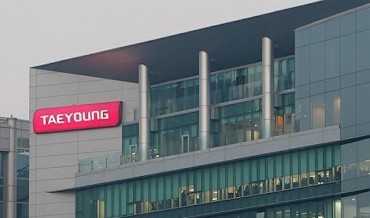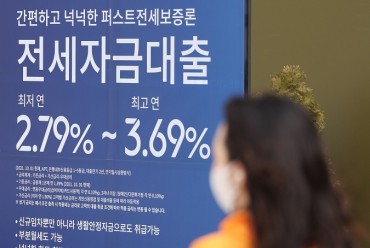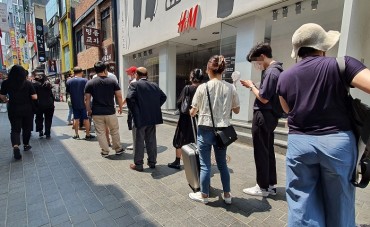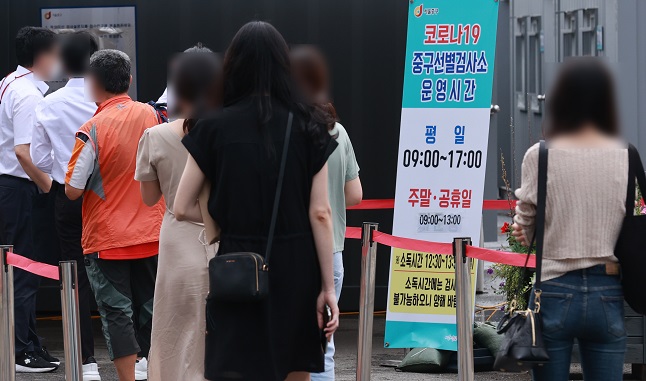
Citizens wait to be tested at a COVID-19 testing station set up in front of Seoul Station in Seoul on June 28, 2021, with the country reporting 501 new cases on the day, including 29 from abroad. (Yonhap)
SEOUL, June 28 (Korea Bizwire) — South Korea’s daily new virus cases fell back to the 500s on Monday for the first time in six days on fewer tests over the weekend.
But health authorities have been keeping tabs on the trend of new virus infections amid concerns over a steady rise in cases of the highly contagious Delta variant and others ahead of the implementation of eased social distancing measures later this week.
During the period from June 20-26, the number of confirmed cases of strains from Britain, South Africa, Brazil and India came to 267, bringing the cumulative number of confirmed cases of variants to 2,492, the health authorities said.
Among the 267 confirmed cases of variants, 189 were the Alpha strain from Britain, followed by the Delta variant from India with 73, Brazil with four and South Africa with one.
By infection route, 196 were domestically transmitted, with 71 from overseas.
The country reported 501 more COVID-19 cases, including 472 local infections, raising the total caseload to 155,572, the Korea Disease Control and Prevention Agency (KDCA) said. The latest figure was down 113 from the previous day.
The country added two more deaths, raising the death toll to 2,015. The fatality rate was 1.3 percent.
As of 9 p.m. Monday, South Korea reported 542 new cases, up 80 from the same time the previous day, according to health authorities and local governments.
Daily cases are counted until midnight and announced the following morning. The greater Seoul area accounted for around 79 percent of the total.
Daily caseloads soared to the 600s from the high 300s on Wednesday due to sporadic cluster infections across the country.
Along with the rise in the number of new virus infections, untraceable cases took up 25.3 percent of the total during the two weeks from June 14.
The health authorities are on alert over the possible rise in new cases as eased social distancing measures will take effect Thursday.
Under the four-tier distancing level to be introduced next month, the greater Seoul area will be under Level 2, allowing restaurants and cafes to open till midnight from the current 10 p.m.
Bars and other nightlife facilities will resume their operations, while the ban on gatherings of five or more people will be lifted to six people until July 14 in the capital area before the ceiling goes up to eight.
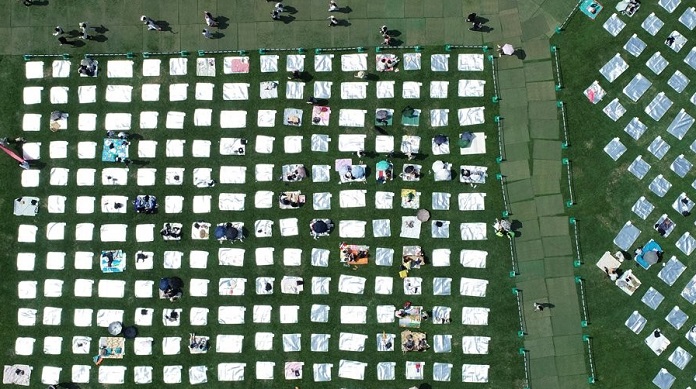
Citizens rest on picnic mats at the “Beautiful Mint Life” music festival at the Olympic Park in Seoul on June 27, 2021, one of the offline festivals held for the first time since new virus cases were confirmed in January 2020, amid recent eased COVID-19 preventive measures related to concerts. (Yonhap)
There will be no restrictions on business operations and the number of people allowed at social gatherings in other areas after the pilot run of new measures for the first two weeks of next month.
Health authorities stressed the need to wear masks ahead of the implementation of the loosened social distancing steps.
Even people who received their first shots of COVID-19 vaccines should wear masks in places such as concert halls, amusement parks and shopping centers, they said.
A total of 15.29 million people, or 29.8 percent of the country’s 51.3 million population, have received their first shots of COVID-19 vaccines since the country started its vaccination program on Feb. 26.
The KDCA said 4.64 million people have been fully vaccinated.
As of June 24, the cumulative number of so-called breakthrough cases reached 44.
A “breakthrough case” is when a person is diagnosed with COVID-19 even after receiving a vaccine shot.
South Korea is trying to inoculate 36 million people by September to achieve herd immunity in November, but it hopes it can reach the goal earlier than expected with the increased vaccine rollout.
The country currently uses vaccines from AstraZeneca, Pfizer, Moderna and Janssen.
According to the health authorities, a total of 1,327 cases of side effects were reported after vaccinations over the weekend.
A total of two post-vaccination deaths were reported, but the exact causes of the deaths remain unknown as causality could not be determined.
Since the country began vaccinations on Feb. 26, a total of 336 deaths after vaccinations were reported, while 95.1 percent of 85,149 cases of side effects reported were found to be mild symptoms.
Of the newly confirmed domestic cases, the capital area accounted for 73 percent, with 179 from Seoul, 157 from Gyeonggi Province and 30 from Incheon, 40 kilometers west of the capital.
There were 29 additional imported cases, down 15 from a day earlier, raising the total to 9,847.
Of the newly confirmed cases from overseas, 12 came from Indonesia, followed by Russia with five.
The number of patients in serious or critical condition came to 141, down six from the previous day.
The total number of people released from quarantine after making full recoveries was 146,675, up 335 from a day earlier, with 6,882 people being isolated for COVID-19 treatment.
(Yonhap)



